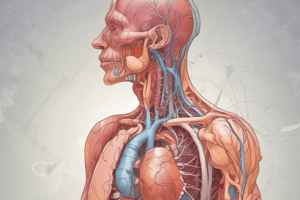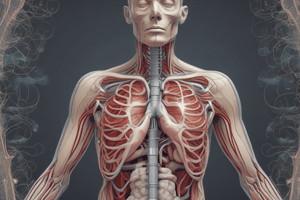Podcast
Questions and Answers
What occurs in response to negative pressure in the thoracic cavity?
What occurs in response to negative pressure in the thoracic cavity?
- Pneumothorax
- Dyspnea
- Inhalation (correct)
- Exhalation
Which of the following symptoms would most likely indicate an issue with the respiratory system during inspection?
Which of the following symptoms would most likely indicate an issue with the respiratory system during inspection?
- Asymmetrical chest movement (correct)
- Normal respiratory rhythm
- Elevated liver enzymes
- Increased heart rate
Which acid–base imbalance results from decreased respiratory function?
Which acid–base imbalance results from decreased respiratory function?
- Metabolic alkalosis
- Respiratory acidosis (correct)
- Metabolic acidosis
- Respiratory alkalosis
What is the primary purpose of auscultation in respiratory assessment?
What is the primary purpose of auscultation in respiratory assessment?
Which adventitious breath sound is generated by narrowed inflamed airways?
Which adventitious breath sound is generated by narrowed inflamed airways?
Which diagnostic test is most appropriate for assessing the structure of the lungs and detecting issues such as tumors or infections?
Which diagnostic test is most appropriate for assessing the structure of the lungs and detecting issues such as tumors or infections?
What vital sign is indicative of worsening respiratory distress in Mr. Granger?
What vital sign is indicative of worsening respiratory distress in Mr. Granger?
In assessing a patient with suspected respiratory acidosis, which of the following findings would you expect?
In assessing a patient with suspected respiratory acidosis, which of the following findings would you expect?
What is a common complication of COPD exacerbations that increases shortness of breath?
What is a common complication of COPD exacerbations that increases shortness of breath?
What key piece of data is least likely to be collected from a patient presenting with respiratory distress?
What key piece of data is least likely to be collected from a patient presenting with respiratory distress?
What is one of the immediate benefits of quitting smoking after 20 minutes?
What is one of the immediate benefits of quitting smoking after 20 minutes?
Which method is NOT considered a therapeutic measure for smoking cessation?
Which method is NOT considered a therapeutic measure for smoking cessation?
What is the risk associated with administering high-flow oxygen therapy for more than 24 hours?
What is the risk associated with administering high-flow oxygen therapy for more than 24 hours?
Which position is recommended for a patient with respiratory distress to optimize lung function?
Which position is recommended for a patient with respiratory distress to optimize lung function?
Which symptom indicates the risk of oxygen toxicity?
Which symptom indicates the risk of oxygen toxicity?
What is a common nursing diagnosis for a patient with a tracheostomy?
What is a common nursing diagnosis for a patient with a tracheostomy?
In which scenario would a partial rebreather mask be most beneficial?
In which scenario would a partial rebreather mask be most beneficial?
What is a key strategy for using a metered-dose inhaler effectively?
What is a key strategy for using a metered-dose inhaler effectively?
Flashcards
Respiratory Acidosis
Respiratory Acidosis
A condition where the body's pH is lower than normal due to too much carbon dioxide in the blood, often from hypoventilation.
Respiratory Alkalosis
Respiratory Alkalosis
A condition where the body's pH is higher than normal due to too little carbon dioxide in the blood, often from hyperventilation.
Assessing Respiratory Distress
Assessing Respiratory Distress
Observing a patient's breathing patterns, chest shape, and accessory muscle usage to evaluate for respiratory distress, including symptoms such as shortness of breath. Consider factors like timing, severity, possible aggravating or relieving factors, and patient perception.
Respiratory Inspection Data
Respiratory Inspection Data
Signup and view all the flashcards
Adventitious Breath Sounds
Adventitious Breath Sounds
Signup and view all the flashcards
Negative Pressure in Thorax
Negative Pressure in Thorax
Signup and view all the flashcards
Respiratory Acidosis Cause
Respiratory Acidosis Cause
Signup and view all the flashcards
Narrowed Airways Sound
Narrowed Airways Sound
Signup and view all the flashcards
Oxygen Saturation 86%
Oxygen Saturation 86%
Signup and view all the flashcards
COPD Patient Shortness of Breath
COPD Patient Shortness of Breath
Signup and view all the flashcards
Smoking Cessation
Smoking Cessation
Signup and view all the flashcards
Smoking Cessation - Recovery Timeline
Smoking Cessation - Recovery Timeline
Signup and view all the flashcards
Oxygen Therapy Risks in COPD Patients
Oxygen Therapy Risks in COPD Patients
Signup and view all the flashcards
Metered-Dose Inhaler (MDI)
Metered-Dose Inhaler (MDI)
Signup and view all the flashcards
Tracheostomy Care
Tracheostomy Care
Signup and view all the flashcards
Tracheostomy Nursing Diagnoses
Tracheostomy Nursing Diagnoses
Signup and view all the flashcards
Oxygen Therapy Methods
Oxygen Therapy Methods
Signup and view all the flashcards
CPAP and BiPAP
CPAP and BiPAP
Signup and view all the flashcards
Study Notes
Respiratory System Function, Data Collection, and Therapeutic Measures
- Learning Outcomes: Describe normal structures and functions of the respiratory system. Identify how aging affects the respiratory system. List data to collect when caring for a patient with a respiratory disorder. Recognize expected findings when inspecting and auscultating the chest. Identify common diagnostic tests to diagnose respiratory disorders. Assist in planning nursing care for patients undergoing diagnostic tests. Discuss therapeutic measures for patients with respiratory disorders.
Review of Anatomy and Physiology
-
Trachea: A rigid tube in front of the esophagus, about 4.5 inches long and 1 inch wide. C-shaped cartilage rings support and prevent collapse during inhalation. Open part of "C" faces posteriorly allowing room for the esophagus during swallowing. Extends from larynx to the carina (cartilaginous ridge).
-
Bronchial Tree: The trachea branches into two primary bronchi at the carina. Supported by C-shaped cartilage initially. Right bronchus is wider and more vertical than left, making it more likely for inhaled objects to lodge there. The primary bronchi branch into secondary bronchi (one for each lobe), then tertiary bronchi. Bronchioles are smaller airways lacking cartilage, then alveolar ducts, leading to clusters of alveoli (primary site for gas exchange).
-
Right Lung: Shorter, broader, and larger than left. Has three lobes (superior, middle, and inferior) and primarily handles gas exchange (55%). Contains horizontal and oblique fissures. Base rests on the diaphragm.
-
Left Lung: Two lobes (superior and inferior) due to the heart's position. Contains an oblique fissure. Apex extends above the first rib. Base rests on the diaphragm.
-
Inspiration: External intercostal muscles pull ribs up and out, widening the thoracic cavity. Diaphragm contracts, flattens, and drops, pressing abdominal organs downward, enlarging thoracic cavity. Air rushes in to equalize pressure.
-
Expiration: Internal intercostal muscles pull ribs down as external intercostals relax. Diaphragm relaxes, bulging upward, and pressing against the base of lungs, reducing the thoracic cavity size. Air is pushed out of lungs.
Acid-Base Balance
-
Respiratory acidosis: Caused by hypoventilation (slow breathing).
-
Respiratory alkalosis: Caused by hyperventilation (rapid breathing).
Effects of Aging
-
Cilia: Hair-like projections in the bronchi, damaged with age. Reduced effectiveness in removing microbes and debris causing increased risk of infections.
-
Respiratory Muscles: Weakened and atrophied with age.
-
Lung Tissue: Reduced elastic recoil with age, making coughing less effective at clearing airways and increasing risk of air trapping.
-
Alveolar Macrophages: Reduced effectiveness reducing infection risk.
-
Alveoli: Number of alveoli decreases with age.
-
Cough Reflex: Less effective at clearing airways.
-
Gas Exchange: Reduced with age causing decreased oxygen intake.
What's Up?
- Where is it? (Location of the problem)
- How does it feel? (Patient's description of symptoms)
- Aggravating and alleviating factors (What makes it better or worse)
- Timing (When did it start, how often)
- Severity (How bad are the symptoms)
- Useful other data (Other pertinent information)
- Patient's perception (How the patient feels about the problem)
Inspection
- Symmetry: Check for equal chest expansion on both sides
- Dyspnea: Difficulty breathing
- Use of accessory muscles: Observing for use of neck muscles with breathing.
- Color: Assessment of skin color (cyanosis, pallor)
- Respiratory rate and rhythm: Evaluate pattern and counting breaths
- Chest shape: Look for deformities
Auscultation
- Normal breath sounds: Listening for normal sounds during regular breathing
- Adventitious sounds: Listening for abnormal breath sounds.
- Compare bilaterally: Compare each side of the lungs.
Adventitious Breath Sounds
- Crackles (coarse or fine)
- Wheezes
- Stridor
- Friction rub
- Diminished
- Absent
Laboratory Tests
- Complete blood count (CBC): Measures blood components.
- Arterial blood gases (ABGs): Measures oxygen and carbon dioxide levels in the blood.
- D-dimer: Measures fibrin degradation products which are released when blood clots dissolve.
- Culture and sensitivity: Bacteria/fungus cultured, and sensitivity tested against antibiotics/anti-fungals.
- Oxygen saturation: Measures the percentage of hemoglobin carrying oxygen.
- Capnography: Measures carbon dioxide concentration in exhaled air.
Diagnostic Tests
- Chest x-ray
- Computed tomography (CT)
- Ventilation-perfusion scan
- Pulmonary function studies
- Pulmonary angiography
- Bronchoscopy
Therapeutic Measures
-
Smoking Cessation:
- Behavior modification
- Counseling
- Setting quit date
- Nicotine replacement
- Drug therapy
- Hypnosis
- Physical activity
- E-cigarettes
-
Breathing Exercises: Deep breathing and coughing; Huff coughing.
-
Positioning: Fowler's position, Semi-Fowler's position, "Good lung down" position.
-
Oxygen Therapy: Nasal cannula, oxygen masks (simple, partial rebreather, nonrebreather, Venturi).
COPD Oxygen Therapy Risk
-
Oxygen toxicity: High-flow oxygen therapy for longer than 24 hours in COPD patients, can cause problems.
-
CO2 Retainers: COPD patients retaining CO2, careful with nasal cannula oxygen.
-
Symptoms: Dry cough, chest pain, numbness in extremities, lethargy, or nausea
Metered-Dose Inhalers
- Medication types: Determine what medication
- Spacer: Use to improve medication delivery.
- Teaching: Education on proper use of inhalers.
- Multiple inhalers: Instructions on using multiple inhalers.
Incentive Spirometer
- Use for patients: Helps patients practice deep breathing.
- Instructions for patients: Expands chest and lungs (creates positive pressure).
Tracheostomy
- Nursing care: Suctioning, cleaning, communication, teaching.
- Infection prevention: Crucial
- Communication: Critical for patients with tracheostomy
- Diagnosis: Ineffective airway clearance, risk for infection, impaired verbal communication, disturbed body image, deficient knowledge.
CPAP and BiPAP
- Indications: Determine usage if necessary.
- Nursing care: Implement appropriate care, and watch for problems or concerns with therapy.
- CPAP explanation: Provides continuous positive airway pressure.
Case Study #1 (Mr. Granger)
- Symptoms: COPD, increased shortness of breath (dyspnea), fever, cough, crackles in lungs, low oxygen saturation (86% at room air).
- Diagnosis (Implied): Cold and likely worsening COPD.
- Treatment: Increased oxygen, likely sent to ER for further assessment / treatment.
- Hand-Off Report: Use ISBARR to give details about patient's history, symptoms, vital signs, and treatment response.
Question #3
- What happens with negative pressure? Inhalation occurs. There is negative pressure in your lungs, causing the lungs to inflate and take in air.
Question #4
- Acid-base imbalance with decreased respiration? Respiratory acidosis.
Question #5
- Adventitious sound from narrowed airways? Stridor.
Studying That Suits You
Use AI to generate personalized quizzes and flashcards to suit your learning preferences.





